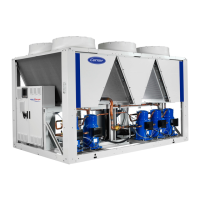
Do you have a question about the Carrier Aquasnap 30RQ 050R and is the answer not in the manual?
Verifies equipment against order, checking for transport damage and missing parts. Compares name plate data.
Safe movement by trained personnel using forklift trucks or slings. Protect coils against crushing. Do not tilt more than 15°.
Install outdoors in a safe, accessible place. Check site loading, level surface, space for air circulation and maintenance.
Provides detailed electrical data including voltage, input power, current draw, and start-up current for different unit capacities.
Details electrical specifications for factory-installed pumps in hydraulic modules, including efficiency, power, and operating conditions.
Provides compressor data including nominal current, maximum current, LRA, and start current values for different compressor types.
Specifies power supply requirements, voltage range, and warnings regarding incorrect voltage or phase imbalance for unit operation.
Emphasizes careful hydraulic circuit connection, water analysis, treatment, material compatibility, and installation of components like filters and valves.
Covers general information, hydraulic circuit cleaning, and flow control procedures for units without a hydraulic module.
Details general information, circuit cleaning, and flow rate adjustment procedures for units with fixed-speed pumps and hydraulic modules.
Explains procedures for hydraulic circuit cleaning and controlling pressure differential using variable-speed pumps in hydraulic modules.
Covers hydraulic circuit cleaning and temperature difference control for units with variable-speed pumps and hydraulic modules.
Outlines pre-start-up checks including installation documentation, visual inspections, refrigerant charge, and electrical connections.
Details commissioning procedures, emphasizing understanding operating instructions, checking connected equipment, and safety device operation.
Lists essential checks for compressors, hydraulics, and refrigerant charge for correct system start-up.
Describes the operating principle of free cooling with drycoolers, including system optimization, fan control, valve operation, and installation guidelines.
Outlines basic maintenance tasks for users: visual inspections for leaks, cleaning air-cooled exchangers, and checking protective grilles.
Details Level 2 maintenance requiring expertise: electrical connection tightening, control checks, and mechanical/hydraulic checks.
Covers advanced maintenance requiring specialist skills: component replacement, refrigerant circuit operations, and leak detection.
Provides important safety warnings and procedures for working on variable frequency drives, emphasizing isolation and qualified personnel.
Checklist for shipping damage, unit installation level, power supply, wiring, ground connection, protection, and terminal tightness.
Checklist for air handling units operation, valve status, fluid piping, air venting, and pump rotation.
Checklist for pump cabling, oil level, leak checks, and voltage imbalance, with warnings for deviations.
Checklist for water loop volume, corrosion inhibitor, frost protection, electric tape heater, and screen filter presence.
Sections to record evaporator inlet/outlet pressure, pressure drop, and determine flow rate using pressure drop curves.
Instructions to perform the QUICK TEST function and log user menu configuration parameters.
Section to record stabilized evaporator water inlet/outlet, ambient temperature, and circuit A/B pressures and temperatures.












